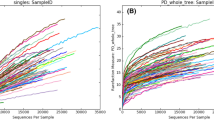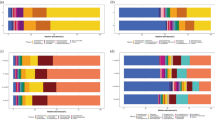Abstract
Microbial communities played a vital role in maintaining homeostasis of ocular surface. However, no studies explored the myopia-associated conjunctiva microbiota changes until now. In this study, conjunctival sac swab specimens were collected from 12 eyes of low myopia (LM), and 14 eyes of high myopia (HM) patients. The V3–V4 region of the 16S rRNA gene was amplified and then sequenced. Statistical analysis was performed to investigate differences in the taxonomy and diversity between two groups. Compared to LM, higher Ocular Surface Disease Index (OSDI) scores were observed in HM group. The Shannon index of the HM was lower than that of the LM group (P = 0.017). Principle coordinate analysis and Partial Least Squares Discrimination Analysis showed distinct microbiome composition between two groups. At the phylum level, there were higher relative abundances of Proteobacteria (68.27% vs 38.51%) and lower abundances of Actinobacteria (3.71% vs 9.19%) in HM, compared to LM group (P = 0.031, 0.010, respectively). At the genus level, the abundances of Acinetobacter in HM (18.16%) were significantly higher than the LM (6.52%) group (P = 0.011). Actinobacteria levels were negatively correlated with the myopic spherical equivalent and OSDI scores. Moreover, positive correlations were found between Proteobacteria levels and OSDI scores, Acinetobacter levels were positively correlated with myopic spherical equivalent and OSDI scores. In conclusion, HM Patients have bacterial microbiota imbalance in the conjunctival sac, compared with LM patients. Proteobacteria, Actinobacteria, Acinetobacter may play roles in the HM associated ocular surface irritation.




Similar content being viewed by others
Data Availability
The data and materials supporting all the results of this study are available from the corresponding author upon the reasonable requests.
References
Alanazi, M. A., El-Hiti, G. A., Al-Madani, A., & Fagehi, R. (2021). Analysis of tear ferning patterns in young female subjects with refractive errors. Journal of Ophthalmology, 2021, 9524143.
Aragona, P., Baudouin, C., Benitez Del Castillo, J. M., Messmer, E., Barabino, S., Merayo-Lloves, J., Brignole-Baudouin, F., Inferrera, L., Rolando, M., Mencucci, R., et al. (2021). The ocular microbiome and microbiota and their effects on ocular surface pathophysiology and disorders. Survey of Ophthalmology, 66, 907–925.
Baird, P. N., Saw, S. M., Lanca, C., Guggenheim, J. A., Smith Iii, E. L., Zhou, X., Matsui, K. O., Wu, P. C., Sankaridurg, P., Chia, A., et al. (2020). Myopia. Nature Reviews Disease Primers, 6, 99.
Bao, L., Liu, Y., Ding, Y., Shang, J., Wei, Y., Tan, Y., & Zi, F. (2022). Interactions between phenolic acids and microorganisms in rhizospheric soil from continuous cropping of Panax notoginseng. Frontiers in Microbiology, 13, 791603.
Chiang, M. C., & Chern, E. (2022). Ocular surface microbiota: Ophthalmic infectious disease and probiotics. Frontiers in Microbiology, 13, 952473.
Cooper, J., & Tkatchenko, A. V. (2018). A review of current concepts of the etiology and treatment of myopia. Eye & Contact Lens, 44, 231–247.
Dong, X., Wang, Y., Wang, W., Lin, P., & Huang, Y. (2019). Composition and diversity of bacterial community on the ocular surface of patients with meibomian gland dysfunction. Investigative Ophthalmology & Visual Science, 60, 4774–4783.
Fagehi, R., El-Hiti, G. A., Alsubaie, M. H., Abusharha, A., Alanazi, M. A., Masmali, A. M., & Almubrad, T. (2022). Measurements of tear evaporation rate in subjects with refractive errors using a portable evaporimeter. Healthcare, 10, 405.
Fahmy, R. M., & Aldarwesh, A. (2018). Correlation between dry eye and refractive error in Saudi young adults using noninvasive Keratograph 4. Indian Journal of Ophthalmology, 66, 653–656.
Flores-Moreno, I., Lugo, F., Duker, J. S., & Ruiz-Moreno, J. M. (2013). The relationship between axial length and choroidal thickness in eyes with high myopia. American Journal of Ophthalmology, 155, 314–319.
Fu, Y., Wu, J., Wang, D., Li, T., Shi, X., Li, L., Zhu, M., Zhang, Z., Yu, X., & Dai, Q. (2022). Metagenomic profiling of ocular surface microbiome changes in Demodex blepharitis patients. Frontiers in Cellular and Infection Microbiology, 12, 922753.
Garza, A., Diaz, G., Hamdan, M., Shetty, A., Hong, B. Y., & Cervantes, J. (2021). Homeostasis and defense at the surface of the eye. The Conjunctival Microbiota. Current Eye Research, 46, 1–6.
Gomes, J. A. P., Frizon, L., & Demeda, V. F. (2020). Ocular Surface Microbiome in Health and Disease. Asia-Pacific Journal of Ophthalmology, 9, 505–511.
Hazra, D., Yotsukura, E., Torii, H., Mori, K., Maruyama, T., Ogawa, M., Hanyuda, A., Tsubota, K., Kurihara, T., & Negishi, K. (2022). Relation between dry eye and myopia based on tear film breakup time, higher order aberration, choroidal thickness, and axial length. Scientific Reports, 12, 10891.
Ilhan, N., Ilhan, O., Ayhan Tuzcu, E., Daglioglu, M. C., Coskun, M., Parlakfikirer, N., & Keskin, U. (2014). Is there a relationship between pathologic myopia and dry eye syndrome? Cornea, 33, 169–171.
Ji, X., Dong, K., Pu, J., Yang, J., Zhang, Z., Ning, X., Ma, Q., Kang, Z., Xu, J., & Sun, B. (2022). Comparison of the ocular surface microbiota between thyroid-associated ophthalmopathy patients and healthy subjects. Frontiers in Cellular and Infection Microbiology, 12, 914749.
Kang, Y., Zhang, H., Hu, M., Ma, Y., Chen, P., Zhao, Z., Li, J., Ye, Y., Zheng, M., & Lou, Y. (2020). Alterations in the ocular surface microbiome in traumatic corneal ulcer patients. Investigative Ophthalmology & Visual Science, 61, 35.
Kim, Y. C., Ham, B., Kang, K. D., Yun, J. M., Kwon, M. J., Kim, H. S., & Hwang, H. B. (2022). Bacterial distribution on the ocular surface of patients with primary Sjögren’s syndrome. Scientific Reports, 12, 1715.
Li, X., Li, M., Han, J., Liu, C., Han, X., Wang, K., Qiao, R., Li, X. L., & Li, X. J. (2022). Correlation between fat accumulation and fecal microbiota in crossbred pigs. Journal of Microbiology, 60, 1077–1085.
Li, Z., Gong, Y., Chen, S., Li, S., Zhang, Y., Zhong, H., Wang, Z., Chen, Y., Deng, Q., Jiang, Y., et al. (2019). Comparative portrayal of ocular surface microbe with and without dry eye. Journal of Microbiology, 57, 1025–1032.
Liang, Q., Li, J., Zhang, S., Liao, Y., Guo, S., Liang, J., Deng, X., Liu, Y., Zou, B., Wen, X., et al. (2021). Characterization of conjunctival microbiome dysbiosis associated with allergic conjunctivitis. Allergy, 76, 596–600.
Litvak, Y., Byndloss, M. X., Tsolis, R. M., & Bäumler, A. J. (2017). Dysbiotic Proteobacteria expansion: A microbial signature of epithelial dysfunction. Current Opinion in Microbiology, 39, 1–6.
Mela, E. K., Drimtzias, E. G., Christofidou, M. K., Filos, K. S., Anastassiou, E. D., & Gartaganis, S. P. (2010). Ocular surface bacterial colonisation in sedated intensive care unit patients. Anaesthesia and Intensive Care, 38, 190–193.
Morgan, I. G., French, A. N., Ashby, R. S., Guo, X., Ding, X., He, M., & Rose, K. A. (2018). The epidemics of myopia: aetiology and prevention. Progress in Retinal and Eye Research, 62, 134–149.
Naik, M. N., Vasanthapuram, V. H., Joseph, J., & Murthy, S. I. (2019). Microbial keratitis in thyroid eye disease: clinical features, microbiological profile, and treatment outcome. Ophthalmic Plastic and Reconstructive Surgery, 35, 543–548.
Okonkwo, A., Rimmer, V., Walkden, A., Brahma, A., Carley, F., McBain, A. J., & Radhakrishnan, H. (2020). Next-generation sequencing of the ocular surface microbiome: In health, contact lens wear diabetes trachoma and dry eye. Eye & Contact Lens, 46, 254–261.
Satchi, K., & McNab, A. A. (2010). Orbital decompression in the treatment of proptosis due to high axial myopia. Ophthalmic Plastic and Reconstructive Surgery, 26, 420–425.
Schiffman, R. M., Christianson, M. D., Jacobsen, G., Hirsch, J. D., & Reis, B. L. (2000). Reliability and validity of the ocular surface disease index. Archives of Ophthalmology, 118, 615–621.
Shin, N. R., Whon, T. W., & Bae, J. W. (2015). Proteobacteria: Microbial signature of dysbiosis in gut microbiota. Trends in Biotechnology, 33, 496–503.
Song, A. P., Wu, X. Y., Wang, J. R., Liu, W., Sun, Y., & Yu, T. (2014). Measurement of retinal thickness in macular region of high myopic eyes using spectral domain OCT. International Journal of Ophthalmology, 7, 122–127.
Song, H., Xiao, K., Chen, Z., & Long, Q. (2022). Analysis of conjunctival sac microbiome in dry eye patients with and without Sjögren’s syndrome. Frontier in Medicine, 9, 841112.
Suzuki, T., Sutani, T., Nakai, H., Shirahige, K., & Kinoshita, S. (2020). The microbiome of the meibum and ocular surface in healthy subjects. Investigative Ophthalmology & Visual Science, 61, 18.
Wu, W., Dou, R., & Wang, Y. (2019). Comparison of corneal biomechanics between low and high myopic eyes—a meta-analysis. American Journal of Ophthalmology, 207, 419–425.
Yan, Y., Yao, Q., Lu, Y., Shao, C., Sun, H., Li, Y., & Fu, Y. (2020). Association between demodex infestation and ocular surface microbiota in patients with demodex blepharitis. Frontiers in Medicine, 7, 592759.
Yotsukura, E., Torii, H., Inokuchi, M., Tokumura, M., Uchino, M., Nakamura, K., Hyodo, M., Mori, K., Jiang, X., Ikeda, S. I., et al. (2019). Current prevalence of myopia and association of myopia with environmental factors among schoolchildren in Japan. JAMA Ophthalmology, 137, 1233–1239.
Zilliox, M. J., Gange, W. S., Kuffel, G., Mores, C. R., Joyce, C., de Bustros, P., & Bouchard, C. S. (2020). Assessing the ocular surface microbiome in severe ocular surface diseases. The Ocular Surface, 18, 706–712.
Acknowledgements
This research supported by the National Natural Science Foundation of China [Number 81870685], the Natural Science Foundation of Beijing Municipality [Number 7172173], the Peking Union Medical College Hospital Deposit Integration Commission Funds [Number ZC201904168].
Author information
Authors and Affiliations
Corresponding author
Ethics declarations
Conflict of Interest
The authors have no conflict of interest to report.
Ethical Statements
The study was approved by local ethics committee of Peking Union Medical College Hospital (ZS-3092) and informed consent was obtained from all study participants.
Supplementary Information
Below is the link to the electronic supplementary material.
Rights and permissions
Springer Nature or its licensor (e.g. a society or other partner) holds exclusive rights to this article under a publishing agreement with the author(s) or other rightsholder(s); author self-archiving of the accepted manuscript version of this article is solely governed by the terms of such publishing agreement and applicable law.
About this article
Cite this article
Xiao, K., Chen, Z. & Long, Q. Comparison of Conjunctival Sac Microbiome between Low and High Myopic Eyes. J Microbiol. 61, 571–578 (2023). https://doi.org/10.1007/s12275-023-00045-5
Received:
Revised:
Accepted:
Published:
Issue Date:
DOI: https://doi.org/10.1007/s12275-023-00045-5




